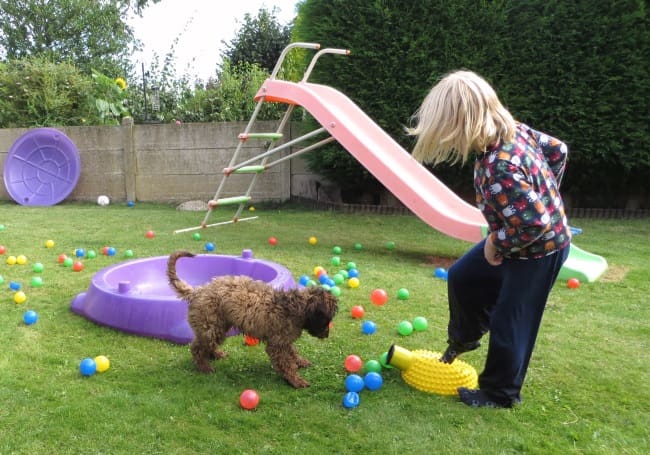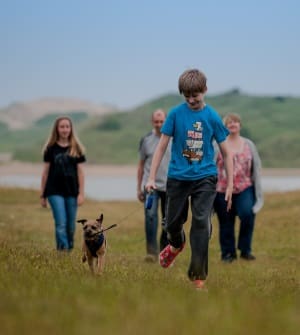School’s out for summer! And while many families are excited at the prospect of six weeks away from routine (not to mention the dreaded school run), life for families with a child with autism spectrum condition (ASC), may be about to get a little more complicated.

The long summer holidays mean time away from the usual routine and days with less structure, which can all create the perfect opportunity for parental and child stress levels to rocket through the roof.
So, can a dog play a role in helping families manage the holidays? Our Family Dog team think so and offer some thoughts on how a dog may be able to help.
Routine and structure
First things first. When we’re talking about routine, there are no greater fans of a structured day than our four-legged friends. Any dog owner will know that changing a dog’s routine can be tricky – the 6.30am wake up call, free-run before 9am, dinner at 6pm, bedtime treat at 9pm…you get the picture! Many people will even tell you that a dog will wait by the door at a certain time of day in anticipation for their owner coming home.
So armed with this knowledge about our dogs and their needs, there’s huge potential to help create some routine and structure for autistic children, too.
Getting out and about
 At the start of the summer holidays, take a bit of time to think about what you usually do with your dog throughout the day and where the family could get involved.
At the start of the summer holidays, take a bit of time to think about what you usually do with your dog throughout the day and where the family could get involved.
The use of social stories and visual timetables, often used in the classroom and at home for autistic children, can help everyone to see the routine around caring for the dog, too.
At breakfast time, the children can help prepare the dog’s breakfast and at the same time they have their own breakfast. Encourage them to help clean the dog’s teeth with a special canine toothpaste, as seeing the dog having its teeth cleaned can help to encourage a child to brush their own teeth and create a positive routine.
A morning walk with the dog can be a way to encourage an anxious child to go outside. One family who attended our Family Dog Workshops made up a treasure-hunt based around a favourite computer game and then followed the clues with their dog. The dog got its walk, the family got out together and everyone enjoyed the activity.
Many families we work with choose to use a dual-lead attached to the dog’s harness, which allows a parent to give instruction to their dog, but also allows the child a calming focus and helps them feel more confident in an outdoor space.
But what about the days when no one wants to go out no matter how much you try? An activity in the garden with the dog may just take the pressure off. Spending 10 minutes in the garden with your dog may just help a parent feel a little less stressed and better prepared to deal with the day ahead. A game of hide-the-treat or perhaps a ball game will help to mentally and physically tire out your dog, and this will assist in promoting a general feeling of being more relaxed.
You could even ask your dog to select an activity for you to do as a family. Write down on two cards a couple of activities you could do as a family – one might say ‘go to the park’ while the other says ‘get an ice-cream’. Most dogs will be inquisitive enough to come and investigate and ‘choose’ an activity by sniffing at the piece of paper.
The great summer dog challenge
Dogs love to learn and play, so why not consider some activities that your children can teach to your dog. With our step-by-step guides, you can teach your dog to do activities such as a beg or roll-over. Over the six weeks of summer you and your family could choose a few different activities to teach your dog and by the end of the summer holidays, you’ll hopefully have a better trained, happier dog and the children feel a heightened sense of achievement.
You can also devise some games to encourage turn-taking and sharing skills. Encourage children to hide treats around the house for a dog to find or hide some treats under upturned flower pots and ask the children to mix them up for the dog to find the hidden treat.
Chilling with your dog
Of course, the holidays are about relaxing too and everyone needs some down time – including our dogs. Dogs need an average 12 – 16 hours sleep a day, so allowing your dog to have regular, undisturbed nap time in a quiet, safe space away from children is really important. And as long as you’re giving your dog the required R&R, time spent snuggling with a four-legged friend can help children to recharge their batteries and feel relaxed and happy.
Training a dog to give a child a head rest or full body rest can give the deep pressure feedback that autistic children can really benefit from.
Learning new tasks- head rest from Dogs for Good on Vimeo.
Many dogs will also appreciate the close contact and feeling part of family activity, so watching a movie together or reading to your dog can be a great way to unwind. If you have a dog who doesn’t love to get close and cuddly, then our blog about ‘Do dogs like to be hugged?’ has some great ideas to consider and help to build up close contact with your dog gradually.
Time for you
Research carried out by the University of Lincoln and supported by Dogs for Good, found one of the most significant benefits of dog ownership to a family with a child with autism was a reduction in parental stress. So, give yourself permission to spend some time with your dog to help you unwind and make the most of some peaceful time and an opportunity to feel healthy.
If getting away from the house isn’t so easy, take some time to relax together in the garden as it could well be the best reward of the day for both you and your dog.